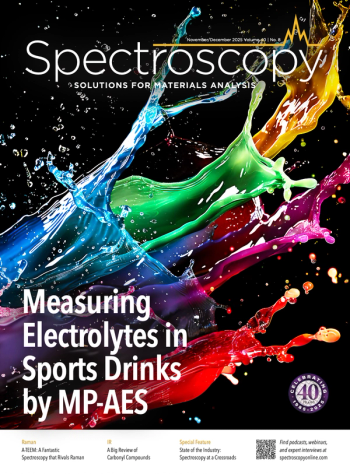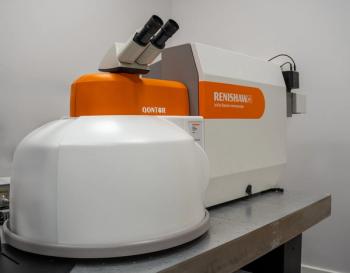
- Advances in ICP-OES and ICP-MS for Today's Spectroscopists
- Volume 39
- Issue s9
- Pages: 36–38
A Combustion-Based Sample Introduction System for Direct Isotopic Analysis of Mercury in Solid Samples via Multi-Collector ICP-Mass Spectrometry: An Interview with Theophilus Redwood Prize Winner Frank Vanhaecke
Frank Vanhaecke and the Atomic & Mass Spectrometry Research Group of Belgium’s Ghent University recently developed a novel method allowing for direct isotopic analysis of mercury (Hg) in solid samples without any prior sample treatment being performed.
Frank Vanhaecke and the Atomic & Mass Spectrometry Research Group of Belgium’s Ghent University (part of the University’s Department of Chemistry) recently developed a novel method allowing for direct isotopic analysis of mercury (Hg) in solid samples without any prior sample treatment. The method was achieved by modifying a commercially available Hg combustion analyzer based on the trapping of Hg vapor on a gold amalgamator and detection using cold vapor atomic absorption spectroscopy (CVAAS) for enabling its coupling to a multi-collector inductively coupled plasma-mass spectrometry (MC-ICP-MS) instrument. Vanhaecke received the 2023 Royal Society of Chemistry Theophilus Redwood Prize, awarded for outstanding contributions to the chemical sciences in analytical chemistry, and will be conducting a plenary lecture, as well as chairing a symposium, at this year’s SciX conference, to be held from October 20 through October 25, in Raleigh, North Carolina. As part of an ongoing series of this year’s SciX conference honorees, Frank spoke to us about the motivation behind the method and the next steps in its development.
What makes multi-collector ICP-mass spectrometry (MC-ICP-MS) a technique of choice in the high-precision isotopic analysis of mercury?
In fact, it is not only the technique of choice, to the best of my knowledge, it is the only technique. To reveal natural variation in the isotopic composition of Hg, a sufficiently high precision is needed. In general, there are two techniques that enable high-precision isotopic analysis of metals and those are thermal ionization mass spectrometry (TIMS) and MC-ICP-MS. In TIMS, the analyte element or a salt of the analyte element is deposited on a metal filament that is then resistively heated in vacuum to produce ions. The high volatility and ionization energy of Hg prevent the use of TIMS for its isotopic analysis, such that this type of analysis was enabled by the introduction of MC-ICP-MS only. ICP-MS is commercially available since 1983 and the ICP is a very powerful ionization source. In 1992, MC-ICP-MS became available as a dedicated tool for high-precision isotopic analysis of metals, metalloids and some non-metals.
What complexities have traditionally been involved in the accurate analysis of mercury in general, and more specifically for the analysis of mercury isotopes?
Compared to other metals, Hg has several peculiar characteristics that open additional possibilities, but at the same time also create challenges. Hg is one of the few elements for which not only mass-dependent, but also mass-independent isotope fractionation occurs. Isotope fractionation refers to the occurrence of differences in the isotopic composition when a compound of an element is distributed over two phases or between the reagent and reaction product. In most cases, the extent of fractionation is correlated with the difference between the masses of the isotopes in the nominator and denominator of an isotope ratio. On top of this, for the odd-numbered isotopes of Hg (199Hg and 201Hg), a behavior different from that of the even-numbered isotopes is accompanying some processes. This apparently aberrant behavior is called mass-independent fractionation, and its characterization provides even more information on the sources, pathways and sinks of Hg. A condition for mass-independent fractionation to be picked up is that the analyte elements show enough isotopes. For Hg with its 7 isotopes, this condition is fulfilled and since there are two odd-numbered isotopes showing this phenomenon, also comparison of their behavior is an additional source of information. The different behavior of these odd-numbered isotopes is hypothetically attributed to differences in size (charge density) and/or magnetic properties of their nuclei and the effect thereof on their electron clouds.
The high vapor pressure of Hg also enables the use of alternative sample introduction systems like cold vapor generation or the combustion approach that we have described, such that target element isolation using a chromatographic protocol which is traditionally required prior to MC-ICP-MS isotopic analysis can be avoided. On the other hand, the high vapor pressure and ionization energy of Hg are also at the origin of memory effects and lower signal intensities.
In your paper (1), you discuss the development and initial evaluation of a combustion-based sample introduction system for direct isotopic analysis of mercury in solid samples via multi-collector ICP-mass spectrometry. Doing so involved the modification of a commercially available mercury analyzer originally designed for quantification of the element through sample combustion. What made you decide to go this route? What challenges in working with mercury made these modifications necessary?
Our activities in the field of Hg isotopic analysis were initiated through a cooperation with colleagues from the Norwegian Institute of Marine Research (IMR). Close to the Norwegian coast, there is a wreck of a German WWII submarine that was torpedoed and sunk while carrying 70 metric tons of metallic Hg. This Hg has leaked (is leaking) into the environment, self-evidently raising concern. While the IMR is specialized in measuring Hg concentrations and Hg speciation analysis, they have contacted us for Hg isotopic analysis as this approach has the capability to provide additional insight into the sources of Hg and the processes it is involved in. Gradually, we were employing Hg isotopic analysis also in a wider context and for samples with a lower Hg content. For securing the high precision needed to reveal and quantify natural variations in the Hg isotopic composition at these lower concentrations, the analytical methodology needed to be revisited. One approach was to address the sample introduction side, and this is what was done in this work. By adapting a commercially available standalone Hg analyzer, we can now carry out direct (as in no prior digestion required) Hg isotopic analysis of solid samples. This approach prevents dilution and should also reduce the risk of contamination. In addition, we should even be able to pre-concentrate the Hg from several sample aliquots on the gold amalgamator that forms an integral part of the unit prior to introduction into the ICP ion source.
What specific changes to the equipment were involved, and what were the challenges associated with making these changes?
This work would not have been possible without a close collaboration between analytical chemists and a technical staff member of our department. A practical challenge was to adapt the gas flows such that oxygen gas was avoided from entering the ICP, while switching between gas flows had to be such that the ICP remained on and stable during the entire protocol. All of this had to be realized within the constraints imposed by the Hg analyzer. The fact that upon completion of the work, the device could still provide information on the Hg concentration (via AAS monitoring) on top of serving as an introduction device for MC-ICP-MS was a bonus.
Other than the technique and equipment being used, does your work differ from what has been previously done by yourself or others?
To the best of my knowledge, this is the first time that solid samples can be directly (as in no digestion required) analyzed for their Hg isotopic composition using an online approach. As indicated before, the development of this approach was initiated by being faced with samples with ever lower Hg concentrations. In addition, this approach should also enhance the sample throughput, which would be an advantage that should also not be underestimated. Isotopic analysis using MC-ICP-MS is not characterized by a very high sample throughput and for drawing environmentally relevant conclusions, often a large collection of samples needs to be measured.
Briefly state your findings.
At a solid sample intake corresponding to 20 ng Hg only, accurate and precise Hg isotope ratio results were obtained for solid reference materials of marine origin (BCR CRM 464 Tuna fish and NRC-CNRC TORT-3 Lobster hepatopancreas). Hg isotope ratio data – expressed as δ202Hg (i.e. the relative difference in the 202Hg/198Hg ratio in a sample versus that in a standard) – can be obtained with a measurement precision of 0.05‰ or 0.005% SD only. An aqueous standard solution can be measured to calculate the δ-value against.
Were there any limitations or challenges you encountered in your work?
The most important challenge during my entire career so far is consolidating our progress within the research group. The group that I am leading consists of PhD students and postdoctoral researchers. I am the only “permanent” member. And since our research area has been quite wide, it has always been challenging, sometimes even impossible, to fully keep the knowledge and experience gained in each subject within the group. This has been (and still is) frustrating at times, especially as I notice that in other academic groups active in the same research area a different organization is indeed possible and would further enhance our strength.
What are the next steps in this research?
This paper reports on the development of the analytical method and a first validation using reference materials of biological origin. In a next phase, we need to characterize the capabilities and limitations into greater detail and evaluate its performance in the analysis of real-world samples.
What are your thoughts regarding your being named the recipient of the Royal Society of Chemistry Theophilus Redwood Prize?
I was very honored to be selected for this award. The team that I lead puts the ICP-MS technique (in all its forms) central, studies fundamentally oriented aspects and develops analytical methodology for addressing real-world applications, typically in an interdisciplinary context. Over the years, I have had the pleasure to work together with many intelligent, creative and motivated “junior” researchers. I interpret winning this award as a recognition for the entire team (previous and current members) and the work we have done and reported on during many years already. The fact that this a “general” analytical chemistry award beyond the area of spectroscopy makes this selection even more meaningful. After the news got out, it was also pleasant to receive congratulations from many colleagues from our field (internationally) and from colleagues at Ghent University from other departments and fields. I have also received many positive comments from former team members, which I have really appreciated because one of the stimulating aspects of my job is seeing young people gaining confidence and reaching scientific maturity. It is very rewarding to see how these former A&MS team members have found or are finding their way in academia, research institutions or industry.
Reference
1. Bolea-Fernandez, E.; Rua-Ibarz, A.; Anjos, J. A.; Vanhaecke, F. Development and Initial Evaluation of a Combustion-Based Sample Introduction System for Direct Isotopic Analysis of Mercury in Solid Samples via Multi-Collector ICP-Mass Spectrometry. Talanta 2024,276, 126210. DOI: 10.1016/j.talanta.2024.126210
Articles in this issue
about 1 year ago
The Importance of Routine Maintenance in ICP-MSNewsletter
Get essential updates on the latest spectroscopy technologies, regulatory standards, and best practices—subscribe today to Spectroscopy.



